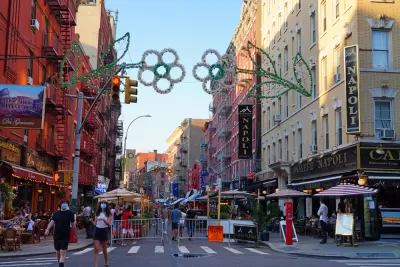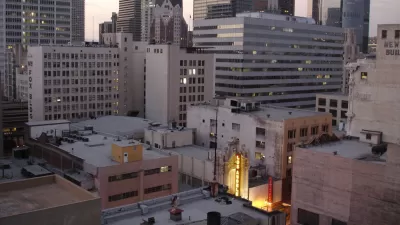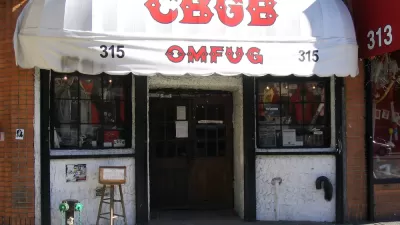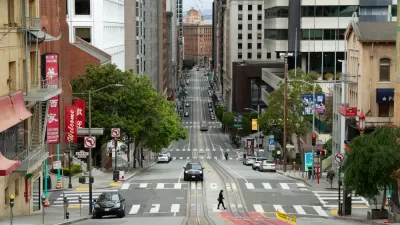Urban cores around the country were transforming into live, work, and play destinations before the pandemic. The pandemic was a setback for this transformation, but it could also be a rare opportunity. It’s up to city leadership to seize it.

“The nation is in the midst of one of the biggest workforce shifts in generations,” writes the Washington Post Editorial Board, describing the effects of nearly three years of stay-at-home orders, working from home, and hybrid work schedules. “Many now have experienced what it is like to work from home and have discovered they prefer it.”
While much of the discussion in cities has focused on the fiscal distress caused by office vacancies, the loss of demand for retail uses in urban cores, declining transit ridership, and shifting commute patterns, less frequently addressed is the opportunity to, for lack of a better phrase, build back better—to turn the crisis of downtown vacancies into an opportunity to solve some of the challenges facing downtowns and regions since even before the pandemic.
The Washington Post writes to refocus the discussion on the opportunities, identifying two obvious opportunities—to return workers to offices and to convert commercial spaces to residential units and entertainment venues.
“This is a once-in-a-generation opportunity to reshape downtowns for the future. It should be a top priority of mayors and city councils around the country,” according to the editorial. “The goal is a ‘24/7’ downtown with ample work spaces, apartments, parks and entertainment venues that draw people in during the day and have a core of residents who keep the area vibrant after commuters go home.”
While that kind of downtown environment was becoming more common in many U.S. cities before the pandemic, many cities had a long way to go in attracting the residential population required to provide a “24-7” downtown.
According to the editorial, both priorities will face substantial challenges, overcome by political will and creative thinking. On the theme of workers returning to the office, D.C. Mayor Muriel Bowser recently called on President Joe Biden to return federal workers to offices for the sake of D.C.’s downtown. New York Mayor Eric Adams has also been a vocal proponent for returning to the office. According to the editorial, workers are already returning to the office, but it’s unlikely they will ever return to pre-pandemic levels. For the foreseeable future, downtowns will be oversupplied with office uses.
So adaptive reuse will be necessary. The editorial identifies a growing interest by developers to begin conversion projects, but multiple hurdles remain. The Washington Post suggests specific actions that can make the most of the opportunity, including setting clear goals for new residents in downtown, speeding up permitting for adaptive reuse projects, creating new financing mechanisms, and thinking beyond housing. More detail on each of these suggestions are available in the source article below.
FULL STORY: Downtowns are lifeless. It’s a once-in-a-generation chance to revive them.

Manufactured Crisis: Losing the Nation’s Largest Source of Unsubsidized Affordable Housing
Manufactured housing communities have long been an affordable housing option for millions of people living in the U.S., but that affordability is disappearing rapidly. How did we get here?

Americans May Be Stuck — But Why?
Americans are moving a lot less than they once did, and that is a problem. While Yoni Applebaum, in his highly-publicized article Stuck, gets the reasons badly wrong, it's still important to ask: why are we moving so much less than before?

Using Old Oil and Gas Wells for Green Energy Storage
Penn State researchers have found that repurposing abandoned oil and gas wells for geothermal-assisted compressed-air energy storage can boost efficiency, reduce environmental risks, and support clean energy and job transitions.

What Forest Service Cuts Mean for Cities
U.S. Forest Service employees work on projects that have impacts far beyond remote, rural wilderness areas.

North Texas Transit Leaders Tout Benefits of TOD for Growing Region
At a summit focused on transit-oriented development, policymakers discussed how North Texas’ expanded light rail system can serve as a tool for economic growth.

Poorest NYC Neighborhoods Pay Price for Delivery Boom
The rise of ‘last-mile’ e-commerce warehouses — and their attendant truck traffic and air pollution — is disproportionately impacting the most historically disadvantaged parts of the city.
Urban Design for Planners 1: Software Tools
This six-course series explores essential urban design concepts using open source software and equips planners with the tools they need to participate fully in the urban design process.
Planning for Universal Design
Learn the tools for implementing Universal Design in planning regulations.
Heyer Gruel & Associates PA
City of Moreno Valley
Institute for Housing and Urban Development Studies (IHS)
City of Grandview
Harvard GSD Executive Education
Salt Lake City
NYU Wagner Graduate School of Public Service
City of Cambridge, Maryland





























